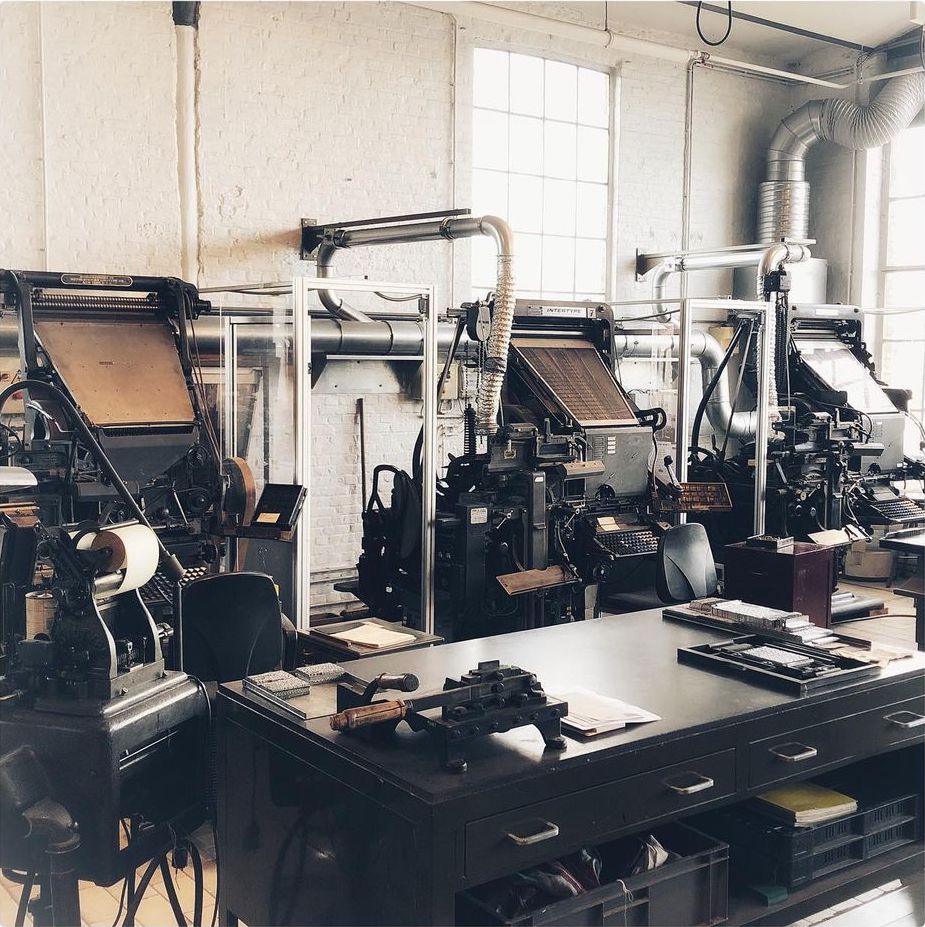
The Linotypes, and their later competitors the Intertypes and the Linographs, were typesetting machines. The output of those machines was a line of type, cast in type metal, hence the name lin-o-type. They were the first machines that succeeded in automating the typesetting process on a large scale, applying a keyboard and automatically sorting the letters back into a magazine. Those machines were invented by Ottmar Mergenthaler at the end of the nineteenth century and they ensured an enormous increase in the amount of printing matter. For that reason, Thomas Edison called them the eighth wonder of the world.
- Those machines are a marvel of engineering. An explanation of their general working can be found on this page.
The stories of the competing companies
- The Linotype was the first machine to successfully speed up the typesetting process. And as long as their patents did not expire, they were the only company to produce linecasters. A timeline of composing linecaster development—the history of the Linotype—can be found on this page. Outside the United States, the Mergenthaler Linotype Company started the following companies:
- Linotype in Canada
- Linotype in Germany
- Linotype in the United Kingdom
- Linotype S.p.A. in Italy
- The Intertype corporation started to produce its own version after the Linotype patents expired around 1910—the popular Intertype.
- The Linograph Manufacturing Company is a third and lesser known competitor, which developed the very reliable Linograph machines.
- Somewhere after WWII, the Czechoslovakian company Zbrojovka Brno developed its own version of the Linotype, but it was never mass produced.
- The 'Leningrad printing machines factory', often abbreviated as 'Lenpoligrafmash' became the Russian producer of linecasting machines.
- Also in China, there has been an Linotype production plant. But only one model has been produced over there.
- Not all sold machines were new. There actually was a huge market for 'rebuild' machines.
- The beginning of the end for hot metal typesetting starts around 1950. Phototypesetting is around the corner and gains popularity.
- The state of the typecasting machines in the 2020's
The different models of the machines
- The different Chinese models
- The different Intertype models
- The different Linotype models, American productions
- The different Linotype models, English productions
- The different Linotype models, German productions
- The different Linotype models, Italian productions
- The different Neotype/Novatype (Russian) models
- The Zetotype (Czech) experiment
- Comments on the different models
The machine's technical specifications
- The different keyboards
- Keyboards: different operation layouts
- Keyboards: the differences between the various countries
- Slugs' dimensions
- Magazines' dimensions: the differences between the companies and between different countries
The matrices
The matrices contain a mold with a letterform in which the type metal was injected. But to set a line of type, many different matrices are needed.
- Read about the very basics regarding matrices and space bands
- Matrix identification—
 —Find your identifier in the largest online databace of Linotype faces
—Find your identifier in the largest online databace of Linotype faces
- Matrix Slides: setting a complete line at once
- Matrices - How they were bought in the shop
- A matrices thickness comparison
- Teeth combination charts
- The matrices production proces
- 3D printed matrices (and the technical problems to take care of)
Maintenance and renovation
To keep the machines in working condition, several regular maintenances are needed.
- The correct maintenance of Intertypes and Linotypes
- The Linotype technicians archive (Dutch)
- The Linotype Legacy Series (English) by the Museum of Printing, Haverhill, Massachusetts, USA,
- Restoring the PXL-MAD Intertype to working condition (Hasselt, Belgium)
- 3D printed parts
Varia
- Linotype accessories
- Trivia
- Registry of the remaining typesetting machines in Europe
- The Linotype Registry by Keenlan Lightfoot, a database of remaining machines in the US.
- A letterpress poster series: [Dutch, large], [Dutch, small].
- Museum Finder (AEPM)
- Beefchicken.com
- Circuitousroot.com
- Drukwerkindemarge.org
- Metal Type
- With its overview of all models
- International Printing museum (page contains a good movie)
- Linotype.org
- Youtube channel of The Museum of Printing, Massachusetts
C 2021-2024 Maarten Renckens and other contributors. All rights reserved. All materials on this website are available for non-commercial re-use, as long as the original author is mentioned and a correct reference to this site is added. Thanks!
All materials are considered copyrighted by the author(s) unless otherwise stated. Some materials from other sources are used. If you find materials on this page which you consider not free from copyright, a notification is appreciated.
All collaborations and additional sources are more than welcome. Please contact info@maartenrenckens.com if you have materials that you deem valuable.
